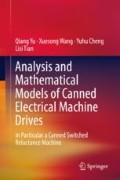Abstract
The can loss is the main constraint to high efficient and high power density operation of canned machines and most analyses are FE based or with resort to empirical equations. Detailed study of the can effect is necessary, which leads to detailed electromagnetic analysis. Electromagnetic field analysis plays the central role in predicting output characteristics. Besides the numerical methods [1, 2], analyses fall into semi-analytical [3, 4] or analytical methods. As to the analytical, a couple of alternatives are predominantly developed. One is the Maxwell’s theorem [5–11]. Specifically in [5, 6], the machine is divided into sub-domains (iron cores, airgap, slots and magnets). Our previous work has been applied on an induction, permanent magnet or switched reluctance machine [8, 12, 13]. Magnetic vector potential of each domain is calculated based on magneto-motive force (MMF) distribution as prerequisite. For simplicity a smooth airgap of constant radial length is assumed. By applying Carter’s factor [14] or airgap permeance function [8], the airgap is radially enlarged to account for slotting effect. Another alternative focuses on airgap flux density by studying respectively airgap permeance function and MMF distribution [9]. However when cans are concerned, both of these methods may cause numerical deviation.
Access this chapter
Tax calculation will be finalised at checkout
Purchases are for personal use only
References
B. Vaseghi, F.M. Tabar, Modeling of non-salient PM synchronous machines under stator winding inter-turn fault condition: dynamic model – FEM model, Conference of Vehicle Power & Propulsion, Arlington, TX, in USA, (2007)
A.M. El-Serafi, X. Liang, S.O. Faried, Factors affecting accuracy of determining the saturated synchronous machines cross-magnetizing parameters by the finite element method, International Conference on Electrical Machines, ICEM 2008, Vilamoura, Portugal
N. Sadowski, M.L. Mazenc, Evaluation and analysis of iron losses in electrical machines using the rain-flow method. IEEE Trans. Magn. 36(4), 1923–1926 (2000)
Q. Yu, B. Bilgin, A. Emadi, Loss and efficiency analysis of a switched reluctance machine for traction application with a new calculation method. IEEE Trans. Ind. Electron. 5(62), 3072–3080 (2015)
G. Dajaku, D. Gerling, Stator slotting effect on magnetic field distribution of salient pole synchronous permanent machines. IEEE Trans. Magn. 46(9), 3676–3683 (2013)
T. Lubin, S. Mezani, A. Rezzoug, Exact analytical method for magnetic field computation in the air gap of cylindrical electrical machines considering slotting effects. IEEE Trans. Magn. 46(4), 1092–1099 (2010)
F. Dubas, C. Espanet, Analytical solution of the magnetic field in permanent-magnet motor taking into account slotting effect. IEEE Trans. Magn. 45(5), 2097–2109 (2009)
Q. Yu, D. Gerling, Analytical modeling of a canned switched reluctance machine with multilayer structure. IEEE Trans. Magn. 49(9), 5069–5082 (2013)
Z.Q. Zhu, D. Howe, Instantaneous magnetic field distribution in pm brushless dc motors – Part III: effect of stator slotting. IEEE Trans. Magn. 29(1), 143–151 (1993)
M. Ojaghi, S. Nasiri, Modeling of Eccentric squirrel cage induction motors with slotting effect and saturable teeth reluctances. IEEE Trans. Energy Convers. 29(3), 619–627 (2014)
D. Zarko, D. Ban, T.A. Lipo, Analytical calculation of magnetic field distribution in slotted air gap of a surface permanent-magnet motor using complex relative airgap permeance. IEEE Trans. Magn. 42(7), 1828–1837 (2006)
Q. Yu, X.S. Wang, Y.H. Cheng, Electromagnetic modeling and analysis of can effect of a canned induction electrical machine. IEEE Trans. Energy Convers. 31(4), 1471–1428 (2016)
Q. Yu, X.S. Wang, Y.H. Cheng, Electromagnetic calculation and characteristic analysis of can effect of a canned permanent magnet motor. IEEE Trans. Magn. 52(2), 1 (2016)
O. Laldin, S.D. Sudhoff, S. Pekanrek, Modified Carter’s coefficient. IEEE Trans. Energy Convers. 30(3), 1133–1134 (2015)
D. Gerling, G. Dajaku, Three-dimensional analytical calculation of induction machines with multilayer rotor structure in cylindrical coordinates. Electr. Eng. 86(4), 199–211 (2004). Archiv fuer Elektrotechnik, Springer
G. Dajaku, D. Gerling, Airgap flux density characteristics of salient pole synchronous permanent magnet machines. IEEE Trans. Magn. 48(7), 2196–2204 (2012)
D. Gerling, Three dimensional analytical calculation of the permanent magnet motor in cylindrical coordinates, Technical report, Professur fuer Antrienbstechnik und Automation, University of Bumdeswehr Muenchen, Munich, Germany, 2003
G. Bertotti, General properties of power losses in soft ferromagnetic material. IEEE Trans. Magn. 24, 621–630 (1988)
H. Mosebach, Eisenverluste von NK Super E-Core Materialen unterschiedlicher dicke und vergleich mit Klassischen Blechqualitaeten, 1999, Availabe at: http://www.iem.ing.tu-bs.de/paper/1999/moseb_99.htm
F. Deng, An improved iron loss estimation for permanent magnet brushless machines. IEEE Trans. Energy Convers. 14(4), 1391–1395 (1999)
Y. Chin, J. Soulrad, Modelling of iron losses in permanent magnet synchronous motors with field-weakening capability for electric vehicles, International Battery, Hybrid and Fuelcell Electric Vehicle Symposium & Exhibition, EVS 19., Korea, 2002
J. Wang, K. Atallah, Z.Q. Zhu, D. Howe, Modular three phase permanent magnet brushless machines for in-wheel applications. IEEE Trans. Veh. Technol. 57(5), 2714–2720 (2008)
J. Li, D.W. Choi, D.H. Son, Y.H. Cho, Effects of MMF harmonics on rotor eddy current losses for inner rotor fractional slot axial flux permanent magnet synchronous machines. IEEE Trans. Magn. 48(2), 839–842 (2012)
G. Dajaku, W. Xie, D. Gerling, Reduction of low space harmonics for the fractional slot concentrated windings using a novel stator design. IEEE Trans. Magn. 50(5), 99–110 (2006)
D. Ishak, Z.Q. Zhu, D. Howe, Comparison of PM brushless motors, having either all teeth or alternate teeth wound. IEEE Trans. Energy Convers. 21(1), 95–103 (2006)
G. Dajaku, D. Gerling, Eddy current loss minimization in rotor magnets of PM machines using high efficiency 12-teeth 10-slots winding topology, International Conference on Electrical Machines and Systems (ICEMS, China, 2011)
Author information
Authors and Affiliations
Rights and permissions
Copyright information
© 2019 Springer Nature Singapore Pte Ltd.
About this chapter
Cite this chapter
Yu, Q., Wang, X., Cheng, Y., Tian, L. (2019). An Analytical Model of Concentric Layer Structure for Canned Machines, Part II: Magnetic Field. In: Analysis and Mathematical Models of Canned Electrical Machine Drives. Springer, Singapore. https://doi.org/10.1007/978-981-13-2745-2_5
Download citation
DOI: https://doi.org/10.1007/978-981-13-2745-2_5
Published:
Publisher Name: Springer, Singapore
Print ISBN: 978-981-13-2744-5
Online ISBN: 978-981-13-2745-2
eBook Packages: EngineeringEngineering (R0)

